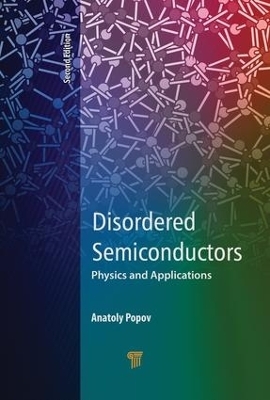
Disordered Semiconductors Second Edition
Pan Stanford Publishing Pte Ltd (Verlag)
978-981-4774-37-6 (ISBN)
Devices based on disordered semiconductors have wide applications. It is difficult to imagine modern life without printers and copiers, LCD monitors and TVs, optical disks, economical solar cells, and many other devices based on disordered semiconductors. However, nowadays books that discuss disordered (amorphous, nanocrystalline, microcrystalline) semiconductors focus, as a rule, on either physics of materials or physics of devices that are based on these materials. This book connects characteristic features of the atomic and electronic structures of disordered semiconductors and the device design process on the basis of these materials.
Compared with the first edition, this book takes into account the latest developments of disordered semiconductors and devices. It has new sections on the structures of carbon-based amorphous and nanocomposite films and atomic and electronic structures of organic semiconductors.
Anatoly Popov is a professor at the Moscow Power Engineering Institute (MPEI), National Research University, Russia, since 1985 and has held positions of the dean of the electro-technical faculty, the first vice-rector, and the head of the Department of Semiconductor Electronics of the institute. He is also principal research scientist in the Institute of Nanotechnology of Microelectronics of the Russian Academy of Sciences and deputy chairman of the Council on Electronics and Telecommunications of the Higher Attestation Commission of Russia. He has also been an academic visitor to Fudan University, Shanghai, China, and an invited lecturer to the Samsung Advanced Institute of Technology, South Korea. He is author or co-author of more than 250 papers published in scientific journals or presented in international conferences and of 6 books on non-crystalline semiconductors. He holds patents of more than 20 inventions. His scientific interests lie in the exploration of the relationship between atomic structure and physical properties of disordered semiconductor materials and in the development of optical storage and electrical memory devices based on these materials.
Preface 1. Introduction 1.1 Definition of Disordered State 1.2 Classification of Non-crystalline Systems 1.3 Qualitative and Quantitative Characteristics of Glass Formation 2. Atomic Structure of Disordered Semiconductors 2.1 Structural Characteristics of Solids 2.2 Short-Range and Medium-Range Order 2.3 Methods of Investigation of Disordered System Structure 2.4 Simulation of Disordered Material Structure 2.5 Results of Structural Research of Disordered Semiconductors 3. Electronic Structure and Properties of Disordered Semiconductors 3.1 Electronic Structure 3.2 Electrical Properties of Disordered Semiconductors 3.3 Optical Properties of Disordered Semiconductors 3.4 Photoelectrical Properties of Disordered Semiconductors 4. Methods for Controlling Properties of Disordered Semiconductors 4.1 Doping of Hydrogenated Amorphous Silicon 4.2 Chemical Modification of Chalcogenide Glassy Semiconductor Film Properties 4.3 Conductivity Type Inversion in Bulk Glassy Chalcogenide 4.4 Structural Modification of Disordered Semiconductors Properties 4.5 Chemical Modification of the Atomic Structure of Disordered Semiconductors 4.6 Structural, Chemical, and Phase Modification of Amorphous Diamond-Like Silicon–Carbon Films 5. Preparation Methods of Disordered Semiconductor Films 5.1 Technological Distinctions of Chalcogenide Glassy Film Preparation 5.2 Preparation of Hydrogenated Amorphous Silicon Films by Glow Discharge Decomposition Method 5.3 Preparation of AIVBIV Alloys on the Base of Hydrogenated Amorphous Silicon 5.4 Preparation of Hydrogenated Amorphous and Microcrystalline Silicon Films by Chemical Vapor Deposition Methods 5.5 Preparation of Hydrogenated Amorphous Silicon Films by Sputtering Method 6. Optical Information Storage and Transmission Devices 6.1 Devices Based on Charge Pattern Recording 6.2 Devices Based on Photo-induced Transformations in Chalcogenide Glasses 7. Photoelectric Devices Based on Disordered Semiconductors 7.1 Renewable Energy Resources 7.2 Conversion of Solar Energy into Electricity 7.3 Photovoltaic Cells Based on Hydrogenated Amorphous Silicon 7.4 Photovoltaic Cells Based on Silicon Heterojunction Technology 7.5 Organic and Hybrid Photovoltaic Cells 8. Electronic Devices Based on Disordered Semiconductors 8.1 Switching and Memory Devices on the Basis of Chalcogenide Alloys 8.2 Silicon Thin-Film Transistors
| Erscheinungsdatum | 19.09.2018 |
|---|---|
| Zusatzinfo | 23 Tables, black and white |
| Verlagsort | Singapore |
| Sprache | englisch |
| Maße | 152 x 229 mm |
| Gewicht | 680 g |
| Themenwelt | Technik ► Elektrotechnik / Energietechnik |
| ISBN-10 | 981-4774-37-5 / 9814774375 |
| ISBN-13 | 978-981-4774-37-6 / 9789814774376 |
| Zustand | Neuware |
| Haben Sie eine Frage zum Produkt? |
aus dem Bereich


